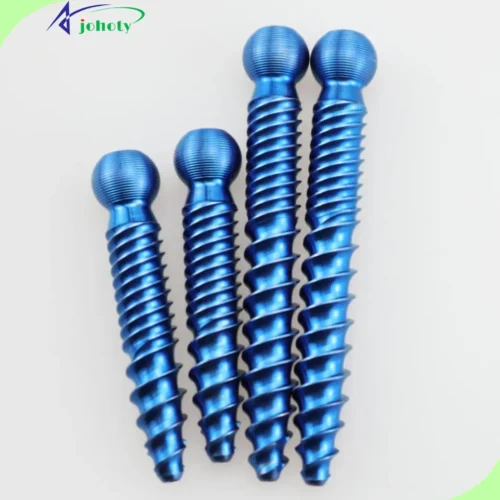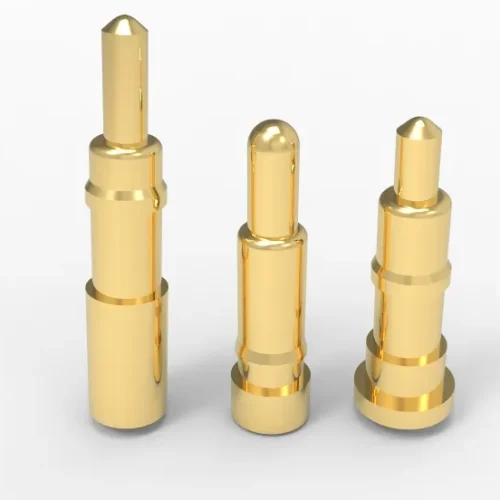Solution for a Dental Implant Screw. For Best Service Quality, cost, and patient satisfaction! Keep Your Practice Ahead of Competitive Market!
A dental implant screw is a dental implant to replace missing teeth. It is usually made of titanium, as titanium is a material that fuses well with human bone. Placing the dental implant screw into the patient’s jawbone without a tooth. On the surface of the dental implant screw, bone cells grow well, anchoring it firmly into the bone. Once the dental implant screw is secure, it can be fitted with a crown, fixed bridge, or removable partial denture. It is to restore dental aesthetics and functions.
Dental implant screw provides a lasting solution to replace missing teeth. It offers more stability and comfort than traditional bridges or dentures while helping to maintain the health of the jawbone.
It prevents jawbone atrophy that may result from long-term tooth loss. However, its success and suitability may vary depending on an individual’s health, oral hygiene practices, and other factors.
What industry pain points does dental implant screw solve?
Our dental implant screw can enhance the most patient experiences. It helps dental professionals optimize the therapy process. Provides dental professionals with more efficient and reliable treatment options and effective tools. Enabling them to address the pain points that have troubled the dental industry for a long time.
Long-term stable solutions for missing teeth
Traditional dental alternatives, such as bridges and removable dentures. They may not provide long-term stability and can lead to problems with adjacent teeth and gums.
A dental implant screw provides a perpetual basis that strongly fuses well with the jawbone. It provides stabilizing support for crowns, fixed bridges, or full dentures. This provides a solution that is both stable and long-lasting.

Prevention of jawbone degeneration
When teeth are lost, the unused area of the jawbone will possibly begin to deteriorate. This can easily impact the stability as well as the reliability of the remaining teeth and the facial structure.
Dental implant screw stimulates bone tissue by imitating natural tooth roots. It helps maintain jawbone density and strength and prevents bone deterioration.
Improve patient satisfaction and comfort
Removable dentures may cause discomfort, limit dietary choices, or require frequent adjustments.
Implant-supported crowns and bridges more closely resemble the function and beautiful appearance of natural teeth. This improves patient comfort and quality of life.
Reduced impact on neighboring teeth
Conventional bridges require grinding away parts of the structure of neighboring teeth. This is possible to impact the standing health of those teeth.
A dental implant screw does not modify neighboring healthy teeth, protecting the structure and health of those teeth.

Flexibility of treatment options
For full mouth reconstruction or complex cases, conventional methods may offer limited solutions.
Dental implant technology offers high flexibility. It allows for individualized treatment plans that accommodate everything from a single missing tooth to full mouth reconstruction.
Improved treatment predictability and success
The long-term success of certain dental restorations may be uncertain.
Dental implants through advanced surgical planning and techniques, such as 3D imaging, CAD, or CAM. This improves the predictability and success of treatment.
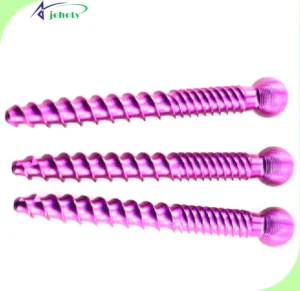
Technician USPs and innovations for the dental implant screw
The technical innovations and USPs of the dental implant screw are reflected in a variety of aspects. Such as material selection, design optimization, surface treatment technology, and integration with digital dental technology. These innovations improve the success rate of implants, shorten treatment cycles, and increase patient comfort.
Material innovations
Titanium alloys and titanium are the best raw materials for dental implant screws because of their excellent osseointegration and biocompatibility.
As a ceramic material, zircon is popular for its good aesthetic results. It is very close to the actual color of natural teeth and has high corrosion resistance. It is particularly suitable for dental implants in the anterior region.

Design optimization
Micro- and macro-design: The design of the dental implant screw is continuously optimized to improve stability within the bone. Macro-design, such as adjustments to the screw shape, thread depth, and pitch. And micro-design, such as improvement to the surface microstructure. It is to improve the stability and accelerate the process of osseointegration.
Various sizes: it is available in different lengths and diameters to suit different patients’ jaw conditions and clinical needs.
Thread design of the implant thread, including depth, width, and shapes of the thread. It is optimized to enhance initial stability and load-bearing capacity. Different thread designs are for different bone densities to achieve optimal
The shapes of the precision dental implant screw, e.g. cylindrical, conical. It is to adapt to different clinical situations. It can provide better initial stability and the ability to cope with different bone conditions.
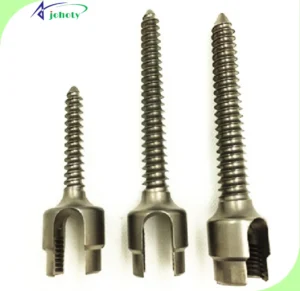
Finish
Rough surfaces are created by sandblasting, acid etching, or laser treatment. It is to increase the contact area between the implant and bone tissue and promote osseointegration.
Bioactive coatings can further promote the integration of the dental implant screw into the bone tissue. Such as hydroxyapatite (HA) and other bioactive substances. They can accelerate the healing process.

Convergence of digital dental technologies
CAD and CAM technology can customize the dental implant screw and crown. It can enhance the efficiency and high accuracy of treatment.
3D Printing Technology can create personalized a dental implant screw and surgical guides for more precise and personalized implant surgery.
Digital planning and navigation system: Through pre-installed 3D imaging and planning software. They can achieve precise planning and execution of surgeries. This can reduce surgical risks and improve success rates.
Instant weight-bearing technology
In some cases, the customer needs to place temporary or permanent crowns immediately or within a short time. it can shorten the treatment cycle after implant placement. And it can improve immediate patient satisfaction.
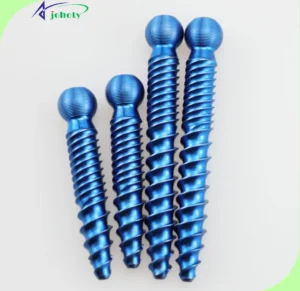
Successful cases of dental implant screw
Successful cases of dental implant screws are widely distributed in clinical practice. It demonstrates the high efficiency and long-term stability of dental implant technology in restoring missing teeth. This has increased the confidence of dental professionals in the use of dental implant screws. Through our continuous technological innovation and improvement, doctors can provide patients with safer, more effective, and more satisfying treatment options.
Dental implant restoration for single missing teeth
A young boy was missing his front teeth due to a sports accident. Considering the young age of the patient, it required both aesthetically pleasing and durable. The dentist recommended the dental implant screw. Through precise surgical planning and the use of high-quality titanium implants. The surgeon successfully placed the dental implant screw and fitted an all-ceramic crown over it. Upon completion of the treatment, the boy regained the natural appearance and function of his teeth. He was very happy with the results.

Bridging solutions for multiple missing teeth
A middle-aged patient had several missing teeth due to years of dental disease, which affected chewing function and aesthetics. Dental experts used several dental implant screws as support. Install a fixed bridge crown to restore the cosmetic and function of the missing tooth area. This avoids the wear of adjacent healthy teeth and provides a more stable and long-lasting solution than traditional bridging.
Reconstruction of a full mouth of teeth
An elderly patient required full mouth dental reconstruction due to advanced age and chronic dental problems. With multiple dental implant screws in conjunction with customized full-mouth dentures. The patient’s chewing was greatly improved while restoring her natural smile and facial contours. This full-mouth dental reconstruction option improved the patient’s quality of life. It also reduced the need for future maintenance due to the stability of the implants.

Immediate weight-bearing implants
A patient in need of an emergency tooth replacement opted for the solution of an immediate weight-bearing implant. After extracting the irreparable tooth, Place the dental implant screw and fit a temporary crown within the same day. A few months later, replace the temporary crown with a permanent crown. This rapid treatment process dramatically reduced the patient’s recovery time and provided immediate aesthetic results.
Individualized treatment for difficult cases
A patient suffering from severe bone loss. He underwent successful dental implant placement through advanced bone regeneration techniques and individualized implant planning. Using 3D imaging and CAM or CAD technology. The patient can customize the implant position and denture to successfully restore dental function and aesthetics.

Economic benefits of the dental implant screw
Although dental implant screw requires a high initial investment. In the long term, their low maintenance costs, durability, and significant improvement in the patient’s life quality. This makes it a competitive advantage option for a valued dental restoration.
Initial investment cost
Implant Cost: Includes the cost of the dental implant screw itself, the crown, and the materials and instruments used during the procedure. The initial cost is often higher a bit than that of a traditional bridge or removable denture.
Surgical Cost: Implant surgery may require specialized dental equipment and techniques, and the cost of the procedure is therefore higher.

Long-term maintenance cost
Low maintenance costs: Once fusing the dental implant screw successfully, long-term maintenance costs are relatively low. because the dental implant screw is designed to mimic natural teeth and is highly durable. It unlikes bridges or removable dentures that can be easily damaged or need to be replaced periodically.
Avoidance of additional treatment costs: traditional bridges can result in damage to adjacent teeth, which may require additional treatment in the future. The dental implant screw avoids this and reduces long-term treatment costs.

Cost-effectiveness versus traditional alternatives
Long-term return on investment: Although the initial investment cost of the dental implant screw is higher than that of bridges or removable dentures. Their high durability and lower long-term maintenance costs make them a highly cost-effective long-term solution.
Quality of Life Enhancement: The dental implant screw provides a more natural chewing sensation and aesthetics. This improves the patient’s quality of life. This non-direct economic benefit is difficult to quantify but is of great value to the patient.
Health Economics
Prevents jawbone deterioration: The dental implant screw prevents the deterioration of the jawbone after long-term tooth loss. It helps to maintain facial structure and avoids the cost of further treatment due to jawbone deterioration.
Reduced risk of complications: The dental implant screw has a very lower risk of complications compared to traditional solutions and alternatives. It greatly reduces potential medical costs.

The future of dental implant screw
Its future is to greatly improve the actual predictability of surgery and greatly drop the risk of complications. We hope to shorten recovery time and improve long-term stability and aesthetics. Intended to improve the success rate of implant surgery, optimize patient experience, and expand the application scope of dental implants.
Material innovation
Research and development of new dental implant screw materials aimed at improving biocompatibility and promoting speed and quality of osseointegration. The new generation of materials may include surface-treated titanium alloys with better bioactivity. Or entirely new bioceramics and composites that more effectively promote the integration of the tooth into the surrounding bone.
Improvements in surface technology
Improvement of implant surface properties through nanotechnology, micro-textured surface design, etc. It is to enhance the adsorption capacity of osteoblasts and accelerate the process of osseointegration. These techniques help to shorten recovery time and improve implant stability.

Digitization and 3D printing technologies
Personalized dental implant screw uses digital scanning, design, and 3D printing technologies. These technologies can provide more precise dental implant screw design and fabrication to suit the patient’s specific oral conditions. Thereby improving surgical success and patient satisfaction.
Minimally invasive surgical techniques
Developing more refined and minimally invasive surgical techniques to reduce intraoperative tissue damage and postoperative discomfort. This may include robot-assisted implantation techniques or advanced navigation systems to improve the accuracy and safety of implantation.
Bioactive coatings
Developing bioactive coatings that release drugs or growth factors to promote bone growth, inhibit bacterial growth, or reduce inflammation. These innovations are expected to improve the long-term success and durability of dental implant screws.
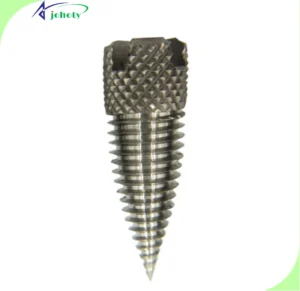
Comprehensive treatment planning
Integration of oral health management and comprehensive treatment planning for implant placement. Including AI involvement for a customized treatment plan. As well as long-term oral health monitoring and management.
Regenerative Medicine and Tissue Engineering
Expanding the range of indications for implant therapy by utilizing stem cell technology and tissue engineering strategies. This is to promote regeneration and repair of damaged bone. It can provide more effective pre-treatment options for patients with missing bone mass.

Conclusion
As we delve into the future of dental implant screw technology, we witness the power of technological innovation. And we also recognize the top importance of interdisciplinary cooperation in pushing this field. From our development of emerging materials to our cutting-edge digital fabrication techniques to advanced minimally invasive surgical methods and the application of bioactive coatings. Every step of progress is a significant effort to give the best treatment options to the patients.

However, technological advances should not be confined to laboratories and research centers. Real progress requires our participation and contribution. This includes researchers, dentists, technology developers, patients, and us who produce various dental implant screws. By strengthening our connections and collaborations, we can accelerate the innovation and application of technology. We also ensure that these advances are truly aligned with the expectations and actual needs of our patients.


